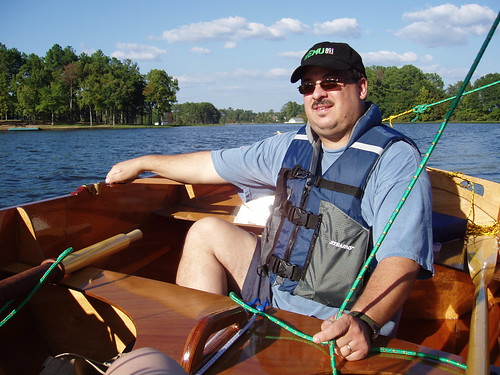Installation of some structure to support the deck came next. The position of the deckbeam was measured relative to the forward bulkhead. The pair of arched, precut plywood pieces had been previously epoxied together, forming a strong beam unit. Holding the piece in place, the ends were marked and cut, then bevelled and planed until they fit snugly in place between the sheer clamp in the correct position. Pilot holes were drilled and countersunk for #8, 1-1/2" bronze screws to hold the beam in place. Next, the centerline was measured by dividing the beam by two. This matched well with the centerline position given by a string stretched from bow to stern on the hull. From the plans, the position of the wood blocks were marked on the deck beam, and these were also drilled and screwed into place. Once everything fit satisfactorily, it was all disassembled. Some mustard epoxy was mixed with silica, and the parts were coated at the joint faces. The beam and then the blocks were screwed back into place. I had intended to install the carlins as well, but decided to let the deck beam parts cure before that. Besides, I only have two bar clamps, and will need two more to do the carlins... Total hours 17.00.
sheer clamp in the correct position. Pilot holes were drilled and countersunk for #8, 1-1/2" bronze screws to hold the beam in place. Next, the centerline was measured by dividing the beam by two. This matched well with the centerline position given by a string stretched from bow to stern on the hull. From the plans, the position of the wood blocks were marked on the deck beam, and these were also drilled and screwed into place. Once everything fit satisfactorily, it was all disassembled. Some mustard epoxy was mixed with silica, and the parts were coated at the joint faces. The beam and then the blocks were screwed back into place. I had intended to install the carlins as well, but decided to let the deck beam parts cure before that. Besides, I only have two bar clamps, and will need two more to do the carlins... Total hours 17.00.
 sheer clamp in the correct position. Pilot holes were drilled and countersunk for #8, 1-1/2" bronze screws to hold the beam in place. Next, the centerline was measured by dividing the beam by two. This matched well with the centerline position given by a string stretched from bow to stern on the hull. From the plans, the position of the wood blocks were marked on the deck beam, and these were also drilled and screwed into place. Once everything fit satisfactorily, it was all disassembled. Some mustard epoxy was mixed with silica, and the parts were coated at the joint faces. The beam and then the blocks were screwed back into place. I had intended to install the carlins as well, but decided to let the deck beam parts cure before that. Besides, I only have two bar clamps, and will need two more to do the carlins... Total hours 17.00.
sheer clamp in the correct position. Pilot holes were drilled and countersunk for #8, 1-1/2" bronze screws to hold the beam in place. Next, the centerline was measured by dividing the beam by two. This matched well with the centerline position given by a string stretched from bow to stern on the hull. From the plans, the position of the wood blocks were marked on the deck beam, and these were also drilled and screwed into place. Once everything fit satisfactorily, it was all disassembled. Some mustard epoxy was mixed with silica, and the parts were coated at the joint faces. The beam and then the blocks were screwed back into place. I had intended to install the carlins as well, but decided to let the deck beam parts cure before that. Besides, I only have two bar clamps, and will need two more to do the carlins... Total hours 17.00.
1 comment:
Excellent! Great to see you back at it Peter. I hope to get back at my Passagemaker shortly. I've squandered a couple of weeks of great weather and now there's actually snow! in the forcast again.
When I get to my blog expect to see a "crazy" platform I designed for my HF boat trailer (reminiscent of my work platform) to haul sheet material, rolls of insulation, and stuff too big to fit in my cars.
Also got to visit CLC's showroom again this spring when my wife and I went to see our kids near Baltimore. John Harris is going to need more display room with CLC's growing fleet.
Best wishes and enjoy the work on your Mill Creek.
Dave
Post a Comment